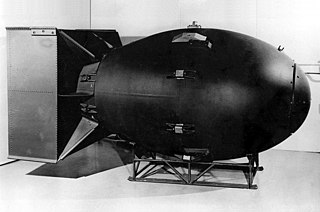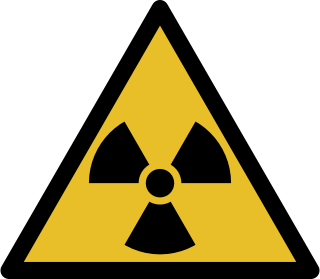Background radiation is a measure of the level of ionizing radiation present in the environment at a particular location which is not due to deliberate introduction of radiation sources.

A Geiger counter is an instrument used for detecting and measuring ionizing radiation. Also known as a Geiger–Mueller counter, it is widely used in applications such as radiation dosimetry, radiological protection, experimental physics, and the nuclear industry.

Nuclear fallout, or fallout, is the residual radioactive material propelled into the upper atmosphere following a nuclear blast, so called because it "falls out" of the sky after the explosion and the shock wave have passed. It commonly refers to the radioactive dust and ash created when a nuclear weapon explodes. The amount and spread of fallout is a product of the size of the weapon and the altitude at which it is detonated. Fallout may get entrained with the products of a pyrocumulus cloud and fall as black rain. This radioactive dust, usually consisting of fission products mixed with bystanding atoms that are neutron activated by exposure, is a kind of radioactive contamination.

Ionizing radiation is radiation that carries enough energy to detach electrons from atoms or molecules, thereby ionizing them. Ionizing radiation is made up of energetic subatomic particles, ions or atoms moving at high speeds, and electromagnetic waves on the high-energy end of the electromagnetic spectrum.

Medical physics is, in general, the application of physics concepts, theories, and methods to medicine or healthcare. Medical physics departments may be found in hospitals or universities.

A scintillation counter is an instrument for detecting and measuring ionizing radiation by using the excitation effect of incident radiation on a scintillating material, and detecting the resultant light pulses.
Radiation protection, also known as radiological protection, is defined by the International Atomic Energy Agency (IAEA) as "The protection of people from harmful effects of exposure to ionizing radiation, and the means for achieving this". The IAEA also states "The accepted understanding of the term radiation protection is restricted to protection of people. Suggestions to extend the definition to include the protection of non-human species or the protection of the environment are controversial". Exposure can be from a radiation source external to the human body or due to the bodily intake of a radioactive material.

Health physics is the applied physics of radiation protection for health and health care purposes. It is the science concerned with the recognition, evaluation, and control of health hazards to permit the safe use and application of ionizing radiation. Health physics professionals promote excellence in the science and practice of radiation protection and safety. Health physicists principally work at facilities where radionuclides or other sources of ionizing radiation are used or produced; these include hospitals, government laboratories, academic and research institutions, nuclear power plants, regulatory agencies, and manufacturing plants.

A gamma counter is a machine to measure gamma radiation emitted by a radionuclide. Unlike survey meters, gamma counters are designed to measure small samples of radioactive material, typically with automated measurement and movement of multiple samples.
In the measurement of ionising radiation the counting efficiency is the ratio between the number of particles or photons counted with a radiation counter and the number of particles or photons of the same type and energy emitted by the radiation source.

A lead castle, also called a lead cave or a lead housing, is a structure composed of lead to provide shielding against gamma radiation in a variety of applications in the nuclear industry and other activities which use ionizing radiation.
Nuclear MASINT is one of the six major subdisciplines generally accepted to make up Measurement and Signature Intelligence (MASINT), which covers measurement and characterization of information derived from nuclear radiation and other physical phenomena associated with nuclear weapons, reactors, processes, materials, devices, and facilities. Nuclear monitoring can be done remotely or during onsite inspections of nuclear facilities. Data exploitation results in characterization of nuclear weapons, reactors, and materials. A number of systems detect and monitor the world for nuclear explosions, as well as nuclear materials production.

Radiation monitoring involves the measurement of radiation dose or radionuclide contamination for reasons related to the assessment or control of exposure to radiation or radioactive substances, and the interpretation of the results.
A nuclear densometer is a field instrument used in geotechnical engineering to determine the density of a compacted material. Also known as a soil density gauge, the device uses the interaction of gamma radiation with matter to measure density, either through direct transmission or the "backscatter" method. The device determines the density of material by counting the number of photons emitted by a radioactive source (cesium-137) that are read by the detector tubes in the gauge base. A 60-second time interval is typically used for the counting period.
Low-background steel is any steel produced prior to the detonation of the first atomic bombs in the 1940s and 1950s. With the Trinity test and the atomic bombings of Hiroshima and Nagasaki in 1945, and then subsequent nuclear weapons testing during the early years of the Cold War, background radiation levels increased across the world. Modern steel is contaminated with radionuclides because its production uses atmospheric air. Low background steel is so called because it does not suffer from such nuclear contamination. This steel is used in devices that require the highest sensitivity for detecting radionuclides.

Radioactive sources are used for logging formation parameters. Radioactive tracers, along with the other substances in hydraulic-fracturing fluid, are sometimes used to determine the injection profile and location of fractures created by hydraulic fracturing.

The Philippine Nuclear Research Institute (PNRI) is a government agency under the Department of Science and Technology mandated to undertake research and development activities in the peaceful uses of nuclear energy, institute regulations on the said uses, and carry out the enforcement of said regulations to protect the health and safety of radiation workers and the general public.



















